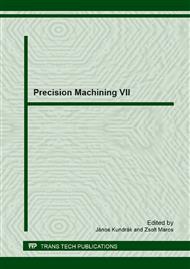[1]
C.С. Tsao. Tool wear and surface roughness prediction using an artificial neural network (ANN) in turning steel under minimum quantity lubrication (MQL), Engineering and Technology, 2010, No. 62, p.830 – 839.
Google Scholar
[2]
S.M. Ali. Modeling of tool wear and surface roughness under MQL condition-a neuralapproach, Canadian Journal on Artificial Intelligence, Machine Learning & Pattern Recognition, 2010, Vol. 1, No. 2, p.7 – 25.
Google Scholar
[3]
F. Basсiftсi. On-line prediction of tool wears by using methods ofartificial neural networks and fuzzy logic, Scientific Research and Essays, 2010, Vol. 5, No. 19, p.2883 – 2888.
Google Scholar
[4]
V.S. Sharma, S.K. Sharma, A.K. Sharma. Cutting tool wear estimation for turning, Journal of Intelligent Manufacturing, 2008, Vol. 19, p.99 – 108.
DOI: 10.1007/s10845-007-0048-2
Google Scholar
[5]
D. Dinakaran, S. Sampathkumar, J.S. Mary. Real Time Prediction of Flank Wear by Neuro Fuzzy Technique in Turning, Jordan Journal of Mechanical and Industrial Engineering, 2010, Vol. 4, No. 6, p.725 – 732.
Google Scholar
[6]
A. Gajate, R. Haber, R. del Toro, P. Vega, A. Bustillo. Tool wear monitoring using neuro-fuzzy techniques: a comparative study in a turning process, Journal of Intelligent Manufacturing, 2012, Vol. 23, No. 3, p.869 – 882.
DOI: 10.1007/s10845-010-0443-y
Google Scholar
[7]
I. Asilturk. On-line surface roughness recognition system by vibration monitoring in CNC turning using adaptive neuro-fuzzy inference system (ANFIS), International Journal of the Physical Sciences, 2011, Vol. 6 (22), p.5353 – 5360.
Google Scholar
[8]
S. Palani, U. Natarajan, M. Chellamalai. On-line prediction of micro-turning multi-response variables by machine vision system using adaptive neuro-fuzzy inference system (ANFIS), Machine Vision and Applications, (2011).
DOI: 10.1007/s00138-011-0378-0
Google Scholar
[9]
U. Zuperl, F. Cus, J. Balic. Intelligent cutting tool condition monitoring in milling. Journal of Achievements in Materials and Manufacturing Engineering, 2011, Vol. 49, No. 2, p.477 – 486.
Google Scholar
[10]
Information on http: /www. grima. ufsc. br/cobef4/files/011122400. pdf.
Google Scholar
[11]
S.S. Gill, R. Singh, J. Singh, H. Singh. Adaptive neuro-fuzzy inference system modeling of cryogenically treated AISI M2 HSS turning tool for estimation of flank wear, Expert Systems with Applications, 2012, Vol. 39, No. 4, p.4171 – 4180.
DOI: 10.1016/j.eswa.2011.09.117
Google Scholar
[12]
P. Kulandaivelu, P.S. Kumar. Investigate the Crater Wear Monitoring of Single Point Cutting Tool Using Adaptive Neuro Fuzzy Inference System, Journal of Applied Science and Engineering, 2012, Vol. 15, No. 3, p.265 – 274.
Google Scholar
[13]
A. Gajate, R.E. Haber, J.R. Alique, P.I. Vega. Transductive-Weighted Neuro-Fuzzy Inference System for Tool Wear Prediction in a Turning Process, 2009, HAIS 2009, LNAI 5572, p.113–120.
DOI: 10.1007/978-3-642-02319-4_14
Google Scholar
[14]
V.A. Zaloga, R.N. Zinchenko, A.V. Gonshchik. The new structure of system for cutting tool condition diagnosis based on utilization of fuzzy logic rules and artificial intelligence systems, Memoirs of the Crimean Engineering and Pedagogical University. Issueк 27. Technical sciences, Simferopol, 2011, p.46.
Google Scholar


